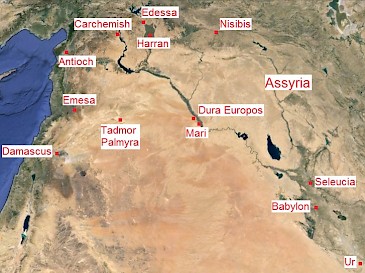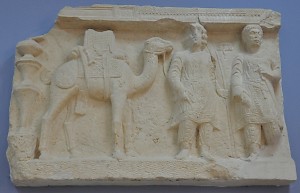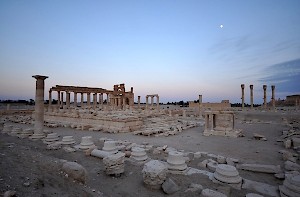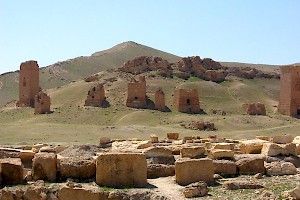Palmyra
Q5747Palmyra or Tadmor: oasis in the desert between Damascus and the Euphrates, important trade center, and capital of a semi-indepent state in the third century CE.
Bronze Age

The ancient Near East has often been described as a fertile crescent: in the southwest we find the valley of the Nile, in the east we find Babylonia, and these two main areas are connected by rivers like the Euphrates, Orontes, and Jordan. As early as 5000 BCE, there was agriculture everywhere between the Zagros mountains in the east to the Nile in the west. At the end of the fourth millennium, the first cities were built. There was monumental architecture. There was trade.
Merchants traveled from Egypt to northern Syria, turned to the east, reached the Euphrates, and followed it downstream to Babylon. Or they migrated in the opposite direction: the Biblical book of Genesis describes how Abraham went from Ur in the deep southeast to Harran, and from there through Canaan, reaching even Egypt.
It was a long trip, but there was a shortcut. Someone coming from Babylon might, once he had reached the general area of Mari or Dura Europos (two cities on the Euphrates), turn directly to the west, through the desert, and reach Emesa or Damascus. There were several oases, where humans and mules could find water. The largest of these was halfway: at 250 kilometers from the Euphrates, 240 kilometers from Damascus, and 200 kilometers from Emesa, was Tadmor or Palmyra,note where a wadi and the Efqa-well facilitated agriculture and made this a desirable resting place for merchants.
Tadmor is mentioned in several very old texts. A cuneiform tablet from Kaneš in Anatolia mentions a man with an Assyrian name, Puzur-Ištar, who is also a tadmurim, “from Tadmor”. This text was written in about 1800 BCE, which suggests that Tadmor was already more than stopover on a caravan road: it was known outside Syria as well. A bit younger are two letters from the archives of Mari,note which refer to the arrival of Tadmorian envoys and the looting of the site by wandering nomads. From the thirteenth century is a reference to three visitors from the oasis, found on a tablet from Emar.

With a length of about 500 kilometers, the desert route was never easy, but the domestication of the dromedary, in the tenth century BCE, made it less difficult: these animals can travel large distances without having to pause for drink. From now on, travelers from the Euphrates to the west needed only one stopover: Tadmor.
First Millennium
In 1110 BCE, the Assyrian king Tiglath-Pileser I boasted:
I have crossed the Euphrates twenty-eight times, twice in one year, in pursuit of the Aramaeans. I brought about their defeat from the city Tadmor of the land Amurru … I brought their booty and possessions to my city Aššur.note

This is the first reference to the Aramaeans, a nation that was to dominate Syria for the next couple of centuries, and was gradually subjected by the Assyrians. Kings like Aššurnasirpal II and Šalmaneser III were to finish the job in the ninth century. Their main road to “Amurru”, as they called Aramaean Syria, was along Nisibis, Edessa, and Karchemish, much to the north of Tadmor, which now disappears from our sources.
In the centuries after Tiglath-Pileser I, Assyria expanded from Iran to Egypt; Assyria collapsed; Babylonia reunited the Near East, collapsed, and was replaced by Persia; Alexander the Great subjected Persia and was succeeded by Seleucus I Nicator. We learn nothing about Tadmor. In Seleucus’ kingdom, the two main centers were Seleucia on the Tigris and Antioch, which were connected by the Euphrates valley. Because Tadmor was not situated on this important road, our sources continue to be silent.

Still, we’re not completely without knowledge. From texts that were written much later, and from archaeological objects from the Roman age, we can deduce that Tadmor was not isolated. There were all kinds of influences. Later generations would venerate Šamaš and Nabu, Babylonian gods representing the Sun and wisdom. In the temple of Ba’al, the Akitu festival was celebrated, another Babylonian borrowing. About half the Palmyrene names would be Arabic, which probably documents a gradual but substantial migration from the south to the north. This can perhaps be connected to the tribal federation of the Qedarites, which migrated Duma in the south to Tadmor and back again.
There is only one reference to Tadmor. The author of the Biblical book of Chronicles, writing at the end of the fourth century, informs his readers that king Solomon had "built Tadmor in the wilderness and all his store cities in Hamath".note Unfortunately, this is untrue. The author is adapting an earlier story, found in the book of Kings, where we read that Solomon "built Tamar in the wilderness of Judah".note The reference in Chronicles only proves that Tadmor was known as far away as Jerusalem.

So, Tadmor was a stopover along a little used caravan road. Things started to change when the Seleucid Empire started to disintegrate. In 141 BCE, the Parthians conquered Iraq, more or less at the same time when the Jews became independent. Merchants from Parthian-ruled Babylonia who wanted to travel to Egypt or the Mediterranean, started to look for different routes: partly because they wanted to avoid the Seleucid-Parthian war zone, partly because Antioch was no longer as important as it had always been.
The oldest monuments of Tadmor, the temple tombs in the western valley, date back to this age. Soon, there would be many more monumental buildings.